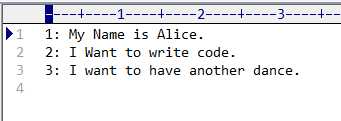本文旨在以实例的方式说明java的文件io操作的基本方法和流程。
源代码
1 import java.io.*; 2 3 public class Main { 4 final static String FILENAME="Alice.txt"; 5 //文件名 6 public static void main(String[] args) { 7 int count=1; 8 String dir=System.getProperty("user.dir"); 9 System.out.println("The default dir is "+dir); 10 //显示当前路径 11 File file=new File(dir+FILENAME); 12 try { 13 file.createNewFile(); 14 //创建文件,当调用createNewFile()方法时已有同名文件,则不做更改返回false 15 }catch (IOException e) 16 { 17 e.printStackTrace(); 18 } 19 if(file.exists()) System.out.println("The file is exist."); 20 if(file.canRead()) System.out.println("The file can read. Lenth: "+file.length()); 21 if(file.canWrite()) System.out.println("The file can write"); 22 //file.delete(); 23 //file.getPath(); 24 //一些file的实用方法 25 PrintWriter printWriter=null; 26 BufferedWriter bufferedWriter=null; 27 //不要在try里声明变量,变量在finally中会访问不了 28 try{ 29 printWriter=new PrintWriter(new FileOutputStream(FILENAME,false)); 30 //如果不存在文件,会创建新文件 31 //第二个参数:Boolean append;true时采用“添加模式”,不创建新文件,false时创建新文件 32 printWriter.println(count++ +": "+"My Name is Alice."); 33 printWriter.println(count++ +": "+"I Want to write code."); 34 printWriter.println(count++ +": "+"I want to have another dance."); 35 //写入文件 36 37 }catch (IOException e) 38 { 39 e.printStackTrace(); 40 } 41 finally { 42 if(printWriter!=null) 43 printWriter.close(); 44 //关闭流 45 } 46 BufferedReader bufferedReader=null; 47 try 48 { 49 bufferedReader=new BufferedReader(new FileReader(FILENAME)); 50 String what; 51 while(bufferedReader.ready()) 52 {//当流中有字符,反复读出 53 what=bufferedReader.readLine(); 54 System.out.println(what); 55 } 56 //读出文件 57 }catch (IOException e) 58 { 59 e.printStackTrace(); 60 } 61 finally { 62 if(bufferedReader!=null) 63 try { 64 bufferedReader.close(); 65 //关闭流 66 }catch (IOException e) 67 { 68 e.printStackTrace(); 69 } 70 } 71 } 72 }

Alice.txt文件↑

控制台↑
